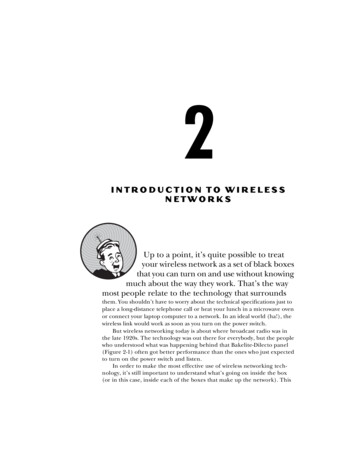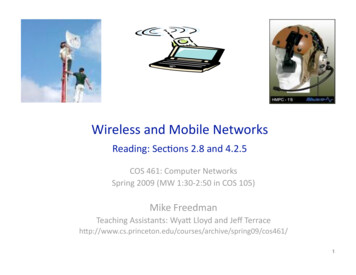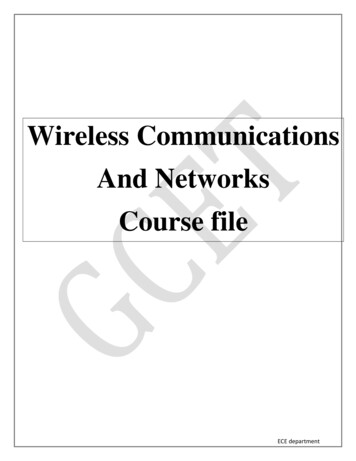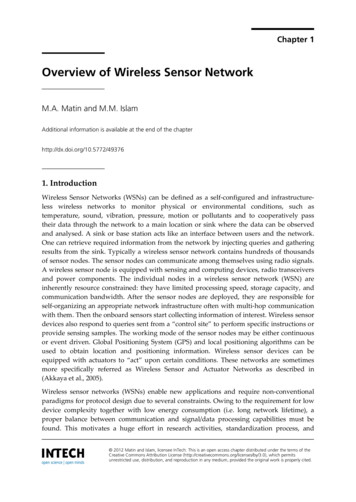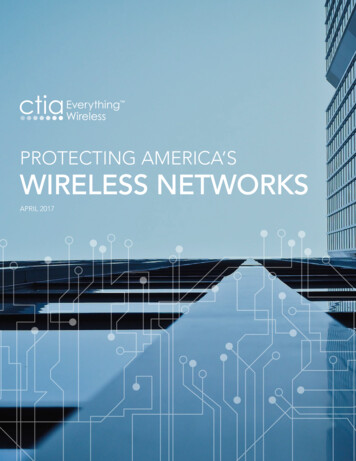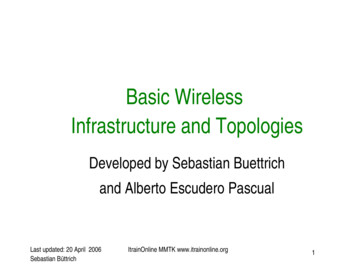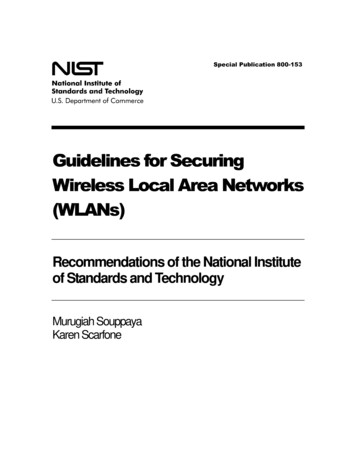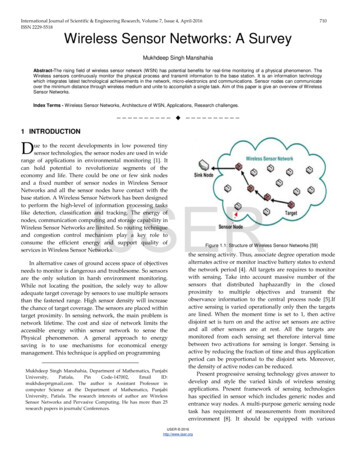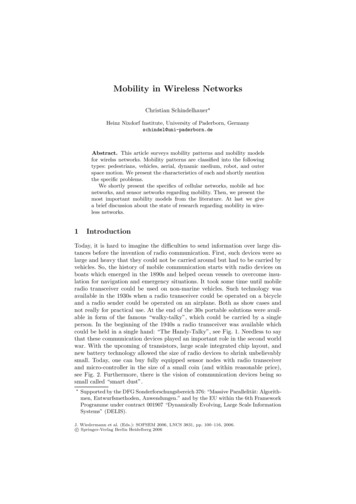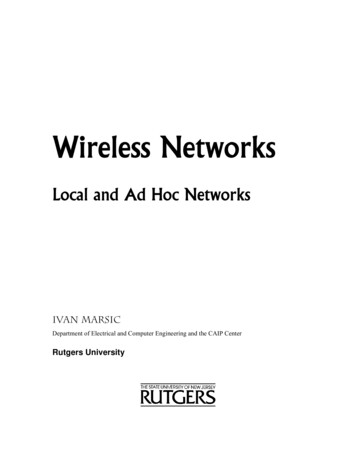
Transcription
Wireless NetworksLocal and Ad Hoc NetworksIvan MarsicDepartment of Electrical and Computer Engineering and the CAIP CenterRutgers University
ContentsCHAPTER 1 . INTRODUCTION.11.1Summary and Bibliographical Notes. 6CHAPTER 2THE RADIO CHANNEL.12.1Introduction. 12.1.1 Decibels and Signal Strength . 42.2Channel Implementation. 52.2.1 Transmission Rate . 52.2.2 Symbols To Signals. 62.2.3 Modulation . 62.2.4 Noise and Error Probability . 102.3Continuous Noisy Channel Capacity. 142.4Radio Propagation: Multipath and Doppler . 202.4.1 Large-Scale Path Loss . 212.4.2 Types of Wave Interactions. 232.4.3 Doppler Shift. 252.4.4 Multipath or Small-Scale Fading . 262.5Equalization, Coding, and Diversity . 292.5.1 Adaptive Equalization . 302.5.2 Channel Coding or Forward Error Correction . 302.5.3 Diversity Techniques for Fading Channels . 312.5.4 Packet Error Rate . 312.6Summary and Bibliographical Notes. 32Problems . 33CHAPTER 3MULTIACCESS COMMUNICATION .36i
Ivan Marsic Rutgers Universityii3.1Introduction. 363.1.1 MAC Protocol Performance Measures. 393.1.2 Propagation Time and Parameter β . 403.1.3 Vulnerable Period . 413.2ALOHA Protocols . 423.2.1 Throughput Analysis. 433.3Carrier Sensing Protocols. 483.3.1 Throughput Analysis of Nonpersistent CSMA. 513.3.2 CSMA/CD . 543.3.3 CSMA/CA. 543.4Other MAC Protocols. 563.5Multiple-access Interference . 563.5.1 Physical Layer Interference. 573.5.2 Link Layer Interference: Hidden and Exposed Stations . 583.6Summary and Bibliographical Notes. 61Problems . 61CHAPTER 4IEEE 802.11 WIRELESS LAN.684.1Introduction. 684.1.1 Architecture and Services . 684.1.2 Beacons. 724.2Medium Access Control. 724.2.1 Interframe Spaces. 734.2.2 Virtual Carrier Sensing and Network Allocation Vector . 754.2.3 ARQ and Atomic Operations . 754.2.4 Backoff Procedure with the DCF. 784.2.5 Hidden and Exposed Stations . 794.2.6 Frame Structure. 814.3Physical Layer and Rate Adaptation . 824.3.1 Physical Signals. 824.3.2 Transmission Rate Adaptation. 834.4Power-saving Mechanisms . 854.4.1 Effect on Capacity . 874.5Performance Analysis. 884.5.1 Channel Event Probabilities . 894.5.2 Throughput and Delay Performance. 92
Chapter 1 Introduction to Computer Networksiii4.6IEEE 802.11 Family of Standards . 944.7Summary and Bibliographical Notes. 98Problems . 98CHAPTER 55.1AD HOC NETWORKS .103Introduction. 1035.2Routing Algorithms . 1045.2.1 Dynamic Source Routing (DSR) Protocol. 1055.2.2 Ad Hoc On-Demand Distance-Vector (AODV) Protocol. 1075.2.3 End-to-End Path Capacity. 1085.2.4 Mobility . 1085.3Capacity . 1085.3.1 Capacity of Mobile Ad Hoc Networks. 1085.3.2 Measured Scaling Law . 1095.4MAC Protocols . 1095.5User Mobility . 1095.6Summary and Bibliographical Notes. 110Problems . 110CHAPTER 66.1TECHNOLOGIES AND FUTURE TRENDS.111Introduction. 1116.2Heterogeneous Wireless Networks . 1126.2.1 3G Cellular Services. 1136.2.2 Hybrid Networks . 1146.3Sensor Networks . 1156.3.1 Data Gathering and Aggregation . 1166.3.2 Commercial Sensor Networks . 1166.4Mobile Ad-hoc Networks. 1176.4.1 Why MANETs? . 1176.5Community Networks . 1196.6Cognitive (Software) Radio . 1216.7Summary and Bibliographical Notes. 122
Ivan Marsic Rutgers UniversityivSOLUTIONS TO SELECTED PROBLEMS .123REFERENCES.140ACRONYMS AND ABBREVIATIONS .145INDEX.147
Chapter 1IntroductionIn this text I review basic results about wirelesscommunication networks. Communication may be defined asthe process of successfully transferring information betweentwo or more parties. My emphasis is on computation ratherthan physics of the processes, while keeping in mind thatunderstanding the physics is necessary to design thecomputation.The recurring theme in this chapter is the capacity and itsstatistical properties for a communication channel. Capacityis modeled differently at different abstraction levels, but thekey issue remains the same: how to increase the amount ofinformation that can be transmitted over a channel in thepresence of channel impairments. A complement of capacityis delay, and although it crops up sporadically, the treatmentof delays is deferred to the next chapter.The main difference between wired and wireless networks isthat there are no wires (the air link) and mobility is thusconferred by the lack of a wired tether. This leads to both thetremendous benefits of wireless networks and the perceiveddrawbacks to them. Some of the key technical challenges inwireless communications come from (i) the hostile wirelesspropagation medium and (ii) user mobility. Most of the issuescovered in this chapter arise in any data network, wired andwireless likewise. What makes the wireless different is thedegree of importance inherent to the problems that oftenappear in both types of networks. Some examples are asfollows.Contents1.1 x1.1.1 x1.1.21.1.31.1.41.2 x1.2.1 x1.2.21.2.31.2.41.3 x1.3.1 x1.3.21.3.31.3.41.3.51.3.61.4 x1.4.1 x1.4.21.4.31.4.41.4.51.6 Summary and Bibliographical Notes Errors due to channel noise occur both in wired and wireless networks, but in the formerthey play only a minor role. Conversely, in wireless networks, channel errors are a majorconcern. Moreover, due to dynamic changes in the transmission medium and usermobility, the error probability changes dynamically over a wide range. Both wired and wireless networks employ broadcast where multiple stations use the samemedium for communication. However, in the wireless case “listening while speaking” is1
Ivan Marsic Rutgers University2complicated, so coordinating the medium access or MAC (Medium Access Control) ismuch more complicated. Both types of networks employ routing to bring a packet to the destination. However,wireless “link” is a relative (or “soft”) concept. Dynamic changes in the transmissionmedium and user mobility often cause severance or emergence of a “link” and theassociated changes in the network topology, i.e., network graph connectivity. The point of belonging to a network is in having relationship with other entities in thenetwork. While a mobile device is moving, the related network entities may be moving ina different direction or not moving at all. This change of the network “landscape”—anuncommon phenomenon in the wired world—presents important challenges from thenetwork management perspective if the network is to provide an undisrupted service tothe roaming user. Energy expenditure is important in both types of networks (recall screen savers andcoolers for wired computers), but battery energy plays a key role in wirelesscommunication. Transmission power also determines the spatial volume within which agiven radio transmission interferes with other transmissions. Radio resource managementrefers to the control signaling and associated protocols that negotiate the optimal usage ofnetwork radio resources (transmission signal strength and available radio channels) forcommunication. Application drivers are different (e.g., multimedia, sensors, military, etc.)As a result, it is very hard to disentangle the concerns and responsibilities of different networklayers, e.g., MAC, routing, and resource allocation, in wireless networks.Protocol LayeringWhile information is represented and transmitted in the form of signal waveforms,communication between the sender and the receiver is usually viewed as taking place betweendifferent layers of abstraction, which are codified as ISO OSI reference architecture, see Figure1-1. The key design principle is such that a protocol at layer i does not know about the protocolsat layers i 1 and i 1. The aspects of abstraction include the type of service offered and the typeof representation of messages exchanged between the communicating entities. The servicesoffered by a higher abstraction layer are composed of the services offered by the lowerabstraction layers. The type of information grows in abstraction from physical signals and streamsof symbols to software objects.In this chapter I consider the bottom three layers: physical, link, and networking. As will becomeapparent below, the separation of functions between layers is not as clean as it is with point-topoint links and wired networks in general.The key service offered by the physical layer is a symbol stream with a transmission error rate.This is achieved by the physical transmission and reception of signals over the wireless channel,reviewed in Chapter 2. While the physical layer represents messages as discrete entities, usuallycalled frames, the information exchanged between the communicating parties is essentiallyviewed as a continuous signal representing a stream of symbols (bits).
Chapter 1 3IntroductionApplication4: Transport Reliable (TCP) Unreliable (UDP)3: Network End-to-end (IP) Routing Address resolution2: Link IEEE 802.11 WiFi IEEE 802.3 Ethernet PPP (modems, T1)1: PhysicalMAC Radio spectrum Infrared Fiber CopperFigure 1-1: ISO OSI protocol reference architecture. Layers 5 (Session) and 6 (Presentation)are not shown.The link layer deals with the messages at the output of the receiver. Functions exercised at thelink layer can include radio resource management (e.g., power control, transmission rateallocation and error control), and network resource management (e.g., service scheduling and calladmission control). Media access protocols controlling the access to shared medium are describedin Chapter 3 and a detailed example of IEEE 802.11 standard is provided in Chapter 4. Thenetworking layer comprises protocol stack that includes handoff management, locationmanagement, traffic management and control. Then ad hoc wireless networks are brieflyreviewed in Chapter 5. Finally, some emerging future trends are described in Chapter 6.Architectures for Wireless NetworksMobility and lack of tethered links between the communicating entities present unique technicalchallenges. Wireless networks usually exploit the fact that the radio waves die out as they travel,so the same slice of spectrum (frequency channel) can be reused in different locations withminimal interference. A key choice is whether or not to rely on any fixed infrastructure, i.e.,whether all system components are physically movable or stationary.Depending on whether or not there is a fixed infrastructure, wireless systems can be categorizedas either infrastructure systems or ad hoc networks (Figure 1-2). Infrastructure systems have fixednetwork resources in the form of a base station or access point (AP), which performs centraladministration for multiple mobile stations. The base station routes packets between mobilenodes, which do not communicate directly with each other. Infrastructure systems are organizedin cells, which reuse portions of the spectrum to increase spectrum usage at the expense of greatersystem infrastructure. Base stations may have high-bandwidth connections to wired infrastructurenetworks. There is no direct (“peer-to-peer”) communication between users. Rather, each mobilestation sends its message directly to the base station in its cell1, and this local base station routes1In more sophisticated cellular systems, base stations in adjacent cells also receive and process themessage, particularly when the user is near a cell boundary.
Ivan Marsic Rutgers University4the messages to the base station in the cell of the intended recipient. In turn, this remote basestation broadcasts the message within its cell for the receiving mobile station to pick up. Cellularnetworks provide the information transport platform for wireless local area networks (WLANs)and wireless wide area networks (WWANs).Ad hoc networks have no pre-existing (fixed) infrastructure and the network architecture isconfigurable. They are formed by wireless stations which may be mobile and they route paths foreach other. Every station in an ad hoc network can be set up as, and play the role of, a base stationwhere it can directly transmit and receive from other stations in the network. Packets may need totraverse multiple links to reach a destination. Due to the mobility, the routes between stationsmay change dynamically. Ad hoc network can co-exist and co-operate, i.e., exchange datapackets, with an infrastructure-based network.Clearly, real world is not as rigid as the above codification would imply. Another useful conceptis that of wireless mesh networks. Wireless mesh network is a multihop wireless network withmostly static routing nodes. It is a stable ad hoc network—a hybrid between the extreme casesshown in Figure 1-2, where one AP connects multiple (mostly stationary) nodes to the Internet.Mobility may or may not be a problem, and since static nodes can be powered by the electric grid,battery power is not necessarily a problem. Examples of wireless mesh networks include: anintra-home or inter-home wireless network; an enterprise-wide backbone wireless network ofAPs; and, cellular mesh.The characteristics of a mesh are: “Grows” organically Does not necessarily require any “infrastructure” Increases overall network capacity Robust and resilient to faults Self-managing and self-administering Identity and security is a challengeNaming and AddressingNames and addresses play an important role in all computer systems as well as any othersymbolic systems. They are labels assigned to entities such as physical objects or abstractconcepts, so those entities can be referred to in a symbolic language. Since computation isspecified in and communication uses symbolic language, the importance of names should beclear. The main issues about naming include: Names must be unique so that different entities are not confused with each other Names must be resolved with the entities they refer to, to determine the object ofcomputation or communicationThe difference between names and addresses, as commonly understood in computing andcommunications, is as follows. Names are usually human-understandable, therefore variable
Chapter 1 bileNode(c)MobileNode(b)MobileNode(d)Figure 1-2: Examples illustrating different architectures for wireless networks: (a)infrastructure “cellular,” and (b) infrastructure-less ad hoc systems, both based on IEEE802.11 wireless LAN, also called Wi-Fi. The respective network topologies with nodes andlinks are hubs-and-spokes (c), and mesh (d).length (potentially rather long) and may not follow a strict format. Addresses, for efficiencyreasons, have fixed lengths and follow strict formatting rules. For example, you could name yourcomputers: “My office computer for development-related work” and “My office computer forbusiness correspondence.” The addresses of those computers could be: 128.6.236.10 and128.6.237.188, respectively.Separating names and addresses is useful for another reason: this separation allows to keep thesame name for a computer that needs to be labeled differently when it moves to a differentphysical place. For example, a telephone may retain its name when moved to a region with adifferent area code. Of course, the name/address separation implies that there should be amechanism for name-to-address translation, and vice versa.Two most important address types in contemporary networking are: Link address of a device, also known as MAC address, which is a physical address for agiven network interface card (NIC), also known as network adaptor. These addresses arestandardized by the IEEE group in charge of a particular physical-layer communicationstandard
Ivan Marsic Rutgers University6Network address of a device, also known as IP address, which is a logical address. Theseaddresses are standardized by the Internet Engineering Task Force (http://www.ietf.org/)Notice that a quite independent addressing scheme is used for telephone networks and it isgoverned by the International Telecommunications Union (http://www.itu.int/).1.1 Summary and Bibliographical NotesThe recurring theme of this volume is the capacity and its statistical properties for acommunication channel. Observe the probabilistic nature of capacity bounds. In other words, thebounds specify what is valid for many experiments, but cannot say much about an individualexperiment. The capacity of a chain of wireless links is equal to the capacity of the “bottlenecklink,” i.e., the link with the lowest capacity. Notice that the raw channel capacity, considered inChapter 2, is reduced due to contention inefficiency, Chapter 3, and routing overhead, Chapter 5.In addition, packet protocols add overhead (packet header and trailer). This considers only thecommunication loss and assumes that computing nodes (CPU cycles, memory space, etc.) are notbottleneck. Switches in computing nodes may be bottleneck in high-speed networks, see e.g.,[Peterson & Davie 2003].If the data at the receiver have errors that are too frequent for the desired use, the errors can oftenbe reduced by the use of two main techniques: Forward error correction (FEC), using the digital signal processing techniques brieflyreviewed in Chapter 2 Automatic repeat request (ARQ), where the receiver directly requests retransmission oferroneous packets or sender indirectly realizes that a packet must be retransmitted sincean acknowledgement has not arrived within a prescribed timeout periodThe choice between using the ARQ or the FEC technique depends on the particular application.ARQ is relatively inexpensive to implement, but FEC techniques are preferred on systems withlarge transmission delays where ARQ would make delays much worse.It could be observed that there exists a gap between signal processing, i.e., physical layer, andnetwork layer communities. Network-level theoretical models of routing, broadcasting,connectivity, backbones, etc., are commonly based on unrealistic physical layer models.Emerging research themes in wireless networking include: Hybrid ad hoc wireless networks, heterogeneous sensor and ad hoc networks More application scenarios Cross layering design
Chapter 1 Introduction More localized algorithms More testing with real equipment New technologies, e.g., ultra-wideband, software radio Sensor network issues, such as reliability Building working networks out of current fundamentals7This text covers many different topics aspects of computer networks and wirelesscommunications. At many places the knowledge networking topics is assumed and noexplanations are given. The reader should check a networking book; perhaps the two mostregarded networking books currently are [Kurose & Ross 2005] and [Peterson & Davie 2003].Protocol layering and OSI reference architecture is probably best covered by [Tanenbaum 2003].This chapter considers only the bottom three layers: physical, link including MAC, and networklayers. Most of the problems are common for both wired and wireless networks, but there is ashift in emphasis. A key issue with wireless is the interference—it causes a decrease in channelcapacity due to relatively high- and dynamically varying noise. Another issue is link instability,which results in changes of network topology.An interesting generalization of layered communication is available in [Benkler 2000].The material presented in this chapter requires basic understanding of probability and randomprocesses. [Yates & Goodman 2004; Bertsekas & Tsitsiklis 2002] provide excellent introductionand [Papoulis & Pillai 2001] is a more advanced and comprehensive text.
Chapter 2The Radio ChannelContents2.1 Introduction2.1.1 Decibels and Signal Strength2.1.2 x2.1.3 x2.1 Introduction2.2 Channel ImplementationThere are three important aspects to address about acommunication channel:(1) How it works—the way information is “imprinted” ona medium of transmission(2) How to build analytical or empirical model of channelerrors(3) How to minimize the effect of errors on messages (andthus, on the channel capacity)I start with brief
network. While a mobile device is moving, the related network entities may be moving in a different direction or not moving at all. This change of the network “landscape”—an uncommon phenomenon in the wired world—presents important challenges from the network management perspective if the

